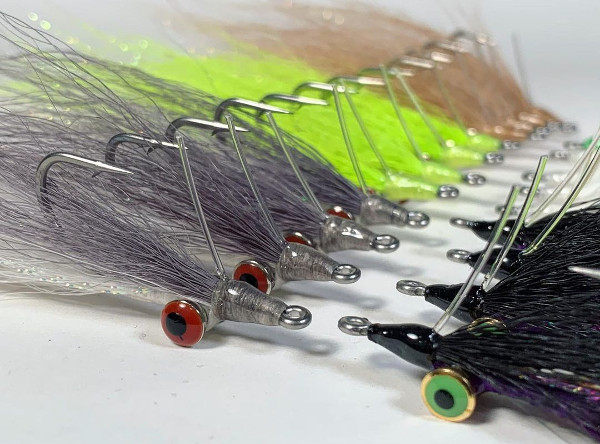
With the increasing popularity of fly fishing, a larger variety of fish species are being targeted on the fly now. Many of them live in weed-heavy environments and require weed-resistant or weed-proof flies. The techniques for tying weedless flies are surprisingly varied, and I covered quite a few below.
The bass and pike anglers reading are likely well-acquainted with weeds. The gear fishing scene has many hooks and lures designed to be weedless, but flies with weedguards are less commonly seen. Most traditional flies used in fly fishing are not designed with weeds in mind. Weeds are not really an issue targeting spring creek wild brookies or swinging flies in traditional steelhead water.
For those of us fly fishing for largemouth bass in heavy cover, or even sea-run brook trout in seaweed riddled estuaries, weedless hooks are often necessary (or at the very least make life much easier). Let’s look at a few different techniques on how to tie weedless flies. Generally we’re talking about streamers when we look at weedless flies, although I have seen some weedless nymph patterns.
Tie in Monofiliment or Wire Weed Guards
You do actually see these style weed guards on some classic fly patterns in addition to newer fly patterns. Tying in a piece of monofilament or two is a classic way of making a fly weed resistant. There are so many ways to use mono weedguards on flies. It’s largely up to personal preference, but some guard designs may work better depending on the specific foliage in the water your fishing.
The material used to block snags may also negatively affect hook-up rates. The more minimalistic methods will impact hookup rates less than the more bulky/ridged methods. For this reason, it’s best to use the most minimalistic method that will still reduce the number of weeds you snag.
One piece of mono
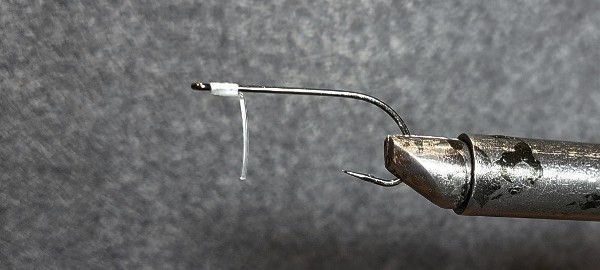
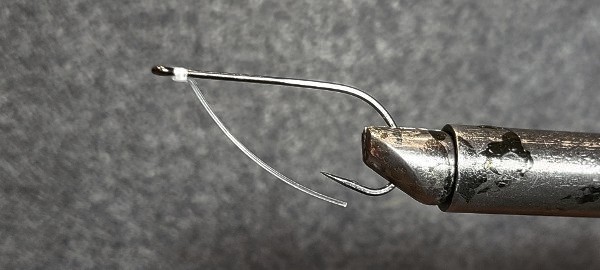
Tying in a single piece of thick mono is the simplest way to make a weedless fly. This will deflect many weeds so they don’t get snagged. Even with one piece of mono, there’s a variety of ways you can tie it in.
I’ve shown two examples above. One pointing straight down, and one sloping back. It’s really down to personal preference. Make sure the mono you use is stiff enough to deflect weeds, but flexible enough to bend out of the way on a strike (so as not to negatively affect your hookup rate).
You could also reverse tie-in guard so it points towards the hook eye and bend it backwards. You could also tie in the mono straight down the same way you would a parachute on a parachute Adams. This would help compensate for a lack of stiffness if you’re using lighter-weight mono.
2 Pieces of mono
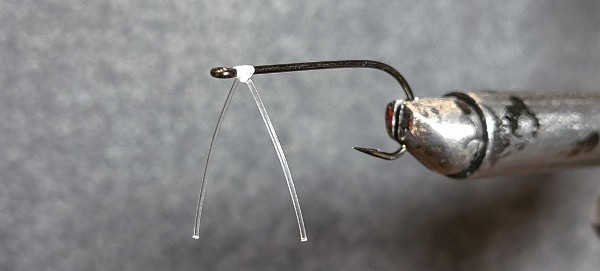
You can also tie a weedless fly by doubling the number of guards. This can be done by tying in two separate pieces of mono/wire.
Tying in a single piece of mono bent at the center also works (as shown above). If going this route, be sure to cross wrap your thread at the tie-in point, you’ll need some extra security to make sure the guard is stiff enough to deflect weeds. You don’t want the fly wearing out prematurely.
You can choose to have them point straight down like shown above, or sloped back towards the hook point. It’s personal preference.
Loop
Incorporating an actual loop into the fly design is another effective way to make a weedless fly.
There’s a couple of very different ways to incorporate a loop and make a fly weedless.
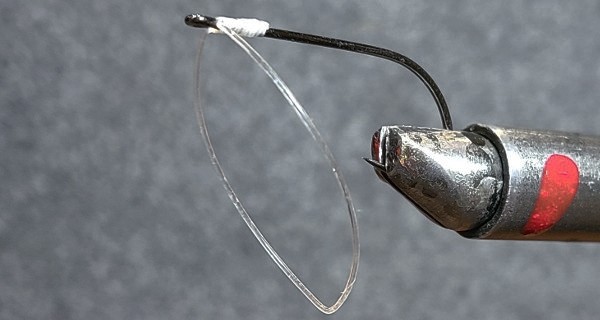
The first (shown above) is just a variation of the previous method. You can tie the loop in behind the hook eye, and have it point downwards past the hook point. You could also have it angle back a bit. Same as 1 or two pieces of straight mono, it’s up to you.
Honestly the example pic above, the loop is about as large as I’d want it. I’d err on making it a bit smaller. A good test for length of the loop, is to bend the guard back, and it should touch just past the hook point.
There is a completely different way of incorporating a loop weed guard into the fly as well. You tie in one end of the loop at the hook eye, and loop it below the hook point before tying it in again near the rear of the hook, on the hook bend. You can do this with either a single loop, or two loops (both shown below).
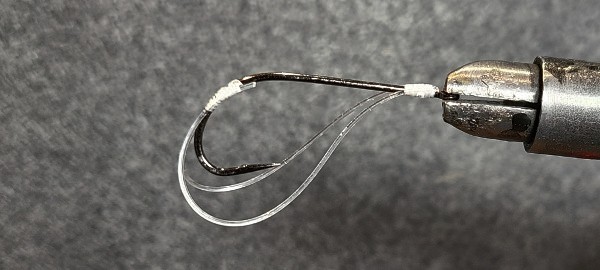
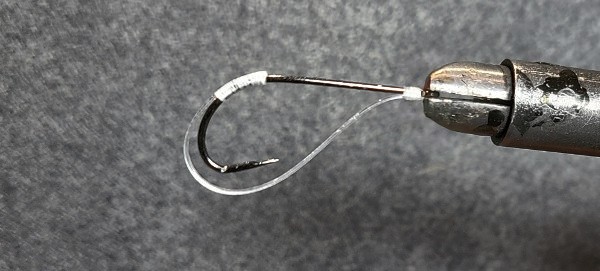
The drawback is that it requires a bit more effort and planning to incorporate this weedguard into a flies design.
You have to secure the mono at the rear tie-in point first. Then tie your fly Finally, finish by securing the mono weed guard(s) behind the hook eye. You need to have some length to the tie-in point at the rear to ensure the mono angles properly
Additionally, if the wire or mono is too stiff, it may negatively impact your hookup rate. Also be sure not to secure the rear tie-in point too far down the hook bend, as that will also negatively affect hookup rate.
You might be tempted to buy some pre-rigged weedless hooks, but I’d advise against it. They would be painfully difficult to tie any flies on. Most weedless designs you see on commercially available hooks can be replicated.
Use offset Hooks
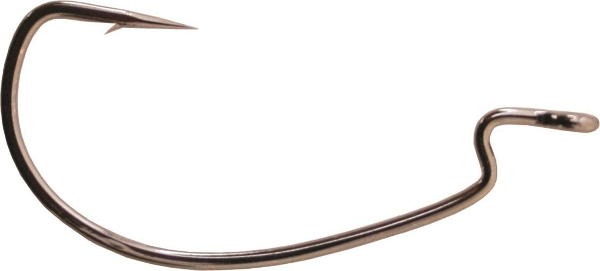
A completely different strategy that completely forgoes a weed guard, and uses a hook that is inherently weed resistant in its design.
Sometimes we can learn alot from our fellow anglers on the gear scene. Bass gear anglers often texas rig their soft plastics on offset hooks to make them weedless. You can do the exact same thing with zonkers! Simply tie in at the front, and rig the zonker the same way a gear angler would rig a soft plastic.
Most offset hooks ride hook point up, which reduces the number of snags you’ll get on the bottom, regardless of whether you make it weedless or not.
It’s not only zonkers though, building a typical baitfish profile with bucktail will cover the hook point on most offset hooks. You can also use any synthetic material that is stiff enough to get the same effect. This makes the fly quite weed resistant.
The Gamakatsu Offset Wide Gap Hook (Amazon Link) is an excellent larger hook for these types of applications.
The main downside of this technique is that there isn’t much room to tie materials on near the head. This can be tricky to work around, particularly for a novice fly tyer. There is a solution though! Keep reading.
Use Flexible Extensions
I’m a big fan of Gunnar Brammer’s flies, and I came across a video of his that blew my mind.
A big issue with tying on offset hooks, is the small amount of shank length you have to tie on. Gunnar found a solution for this.
The head is tied on the front part of the hook, just like most flies tied on offset hooks. The magic comes from an extended body tied in behind the hook eye. This increases the length of the tie-able shank significantly. But wait, a rigid wire extension would negatively impact hook-up rate right? There’s a solution for that as well! Tie the extension on using a flexible (but still relatively stiff) titanium wire. This allows the fly to flex downwards during a strike, better exposing the hook point for a solid hook up.
Check out his video on it below for a fantastic example fly tied this way, and an explanation on the advantages of this setup.
The example given in the video above is a weedless frog fly. This would be perfect for bass or pike fly anglers.
Tie flies that are inherently weedless in their design.
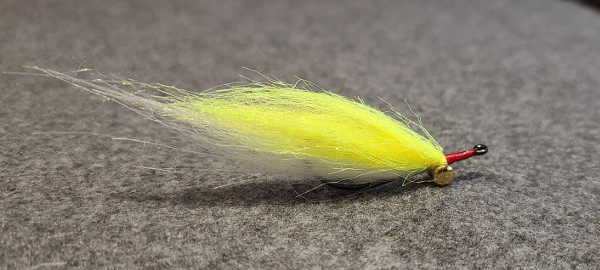
There are also a number of flies that are just inherently weed resistant in their design, even on regular hooks. Generally, these are flies in which the material covers the hook point in some way. A prime example is the Hi-ti craft fur Clouser minnow (shown above). The craft fur obviously isn’t as weed resistant as a mono guard would be, but it does offer some protection. More suitable for resisting loose leafy vegetation than reeds or branches.
You can also tie foam frog patterns using the same method hollow body frog lures are weedless. Loop the foam in such a way that it guards the hook point, and is compressed when a fish bites into the fly. Foam frogs are particularly useful for pike, as their sharp teeth tend to shred bass deerhair bugs.
Hope this helps you fill your fly box with weedless flies! One of the methods mentioned above should work to keep your flies free of weeds while fishing in water with vegetation.

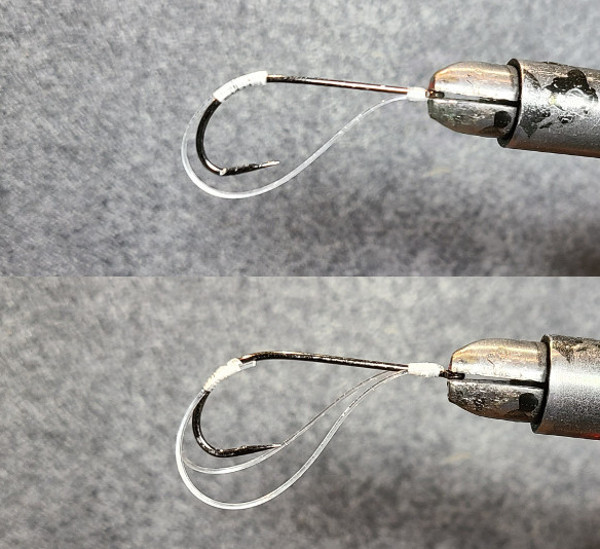
3 thoughts on “9+ Different Methods to Tie Weedless Flies”